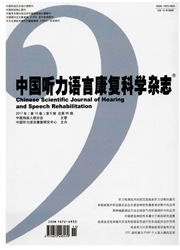

 中文摘要:
中文摘要:
目的评价Waardenburg综合征(Waardenburgsyndrome,ws)患者人工耳蜗植入术后的听觉言语康复效果。方法用纯音听阈、听觉行为分级标准(CategoriesofAuditoryPerformance,CAP)、言语可懂度分级标准(SpeechIntelligibilityRating,SIR)、儿童听觉言语能力家长评估问卷(Parents’EvaluationofAuraI/OralPerformanceofChildren,PEACH),对行人工耳蜗植入术的4例WS1型患者、17例ws2型患者进行术后效果调查,并与非综合征且无明显病因的人工耳蜗植入患者比较,用SPSS13.0进行统计学分析。结果9例WS患者与9例对照组患者术后平均助听听阀(250Hz、500Hz、1000Hz、2000Hz、4000Hz)比较,差别无统计学意义(P〉0.05)。WS患者组CAP评分、SIR评分、安静环境下得分比、噪声环境下得分比、电话交流得分与对照组相比,差异均无统计学意义(P〉0.05);WSl型组患者CAP评分、SIR评分、安静环境下得分比、噪声环境下得分比、电话交流得分与WS2型组患者相比,差异均无统计学意义(P〉0.05),所有患者安静环境下得分比明显高于噪声环境下得分比(P〈O.05)。结论伴有重度或极重度感音神经性聋的Waardenburg综合征患者人工耳蜗植入术后的听觉言语能力与耳蜗形态正常的重度或极重度感音神经性聋患者无显著差别,安静环境下听觉言语能力好于噪声环境下听觉言语能力,且WS1型与WS2型患者人工耳蜗植入术后的听觉言语能力无显著差别。
 英文摘要:
英文摘要:
Objection To evaluate the postoperative outcomes of cochlear implant recipients with Waardenburg syndrome(WS). Methods The pure-tone audiometry, Categories of Auditory Performance (CAP), Speech Intelligibility Rating(SIR), Parents, Evaluation of Aural/Oral Performance of Children (PEACH) were performed in 4 children with WS typel and 17 children with WS type2 after cochlear implantation. The outcomes were compared between WS patients and patients with non-syndromic congenital deafness. Results There was no significant difference in average aided hearing thresholds between 9 WS patients and 9 controls(P〉0.05).There was no significant difference in CAP, SIR, scores in quiet,scores in noise and telephone communication scores between WS and non-syndromic patients, as well as WS typel and type2(P〉0.05).The scores in quiet were significantly higher than those in noise in both WS and non-syndromic hearing-impaired patients(P〈0.05).Concluslon The WS patients with severe or profound hearing impairment and non-syndromic hearing-impaired patients show no significant difference in auditory and speech abilities and the scores in quiet are higher than those in noise. There is no significant difference in auditory and speech abilities between WS type1 and WS type 2 patients.
 同期刊论文项目
同期刊论文项目
 同项目期刊论文
同项目期刊论文
 期刊信息
期刊信息
